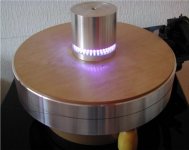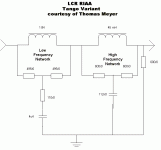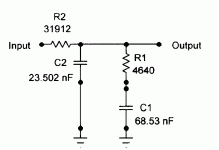Another gratuitous image from:
http://www.audio-consulting.ch/refsystem2002version.htm
I will now wait for the slings and arrows.....
http://www.audio-consulting.ch/refsystem2002version.htm
I will now wait for the slings and arrows.....
Attachments
Jocko,
the this pix you posted is most probably a platter weight with built-in strobe light. The strobe dots are the leds flashing with a very short duty cycle and if the platter is at correct speed, the lighted dots seem to rest, otherwise the seem to run CW or CCW, depending on the speed being to high or too low.
The rest looks quite fancy, and i would not second to use wood as a platter mat. The only correct impedance match for vinyl is vinyl.
LCR RIAA:
much more expensive taste than the illuminated platter weight .
fellow Munich Triode Mafioso Thomas Mayer (vinylsavor) uses such, i guess he uses the Tango RIAA. I haven't yet fully understood why this works and works so §$%&in' good, but it does. It's magic.
C37:
ask me after i have tried it out on a plywood tonearm wand of my mechanical linear tracker soon to come. There are many folks having tried it out and loving it and mayny claiming it never can work and never having tried it out.
i am undecided, curious. Just the price, somehow resmebles snale oil. Main ingredience: stiffening varnish. Used to get the wrinkles out of paper or fabric covering airplane wings. Guess i will have to compare c37 and the stiffening varnish brand smelling like c37
the this pix you posted is most probably a platter weight with built-in strobe light. The strobe dots are the leds flashing with a very short duty cycle and if the platter is at correct speed, the lighted dots seem to rest, otherwise the seem to run CW or CCW, depending on the speed being to high or too low.
The rest looks quite fancy, and i would not second to use wood as a platter mat. The only correct impedance match for vinyl is vinyl.
LCR RIAA:
much more expensive taste than the illuminated platter weight .
fellow Munich Triode Mafioso Thomas Mayer (vinylsavor) uses such, i guess he uses the Tango RIAA. I haven't yet fully understood why this works and works so §$%&in' good, but it does. It's magic.
C37:
ask me after i have tried it out on a plywood tonearm wand of my mechanical linear tracker soon to come. There are many folks having tried it out and loving it and mayny claiming it never can work and never having tried it out.
i am undecided, curious. Just the price, somehow resmebles snale oil. Main ingredience: stiffening varnish. Used to get the wrinkles out of paper or fabric covering airplane wings. Guess i will have to compare c37 and the stiffening varnish brand smelling like c37
Credit where credit is due.
Picture brought to you by H.H. the leading poster of gratuitous images. I would try C37, I'll try anything once. It is just the proposterous explanation of how it works that amuses me. I could tell a better lie than that with 5 minutes preperation. I believe the correct term is Snake Oil. I do use shark's liver oil on my contacts though.
Picture brought to you by H.H. the leading poster of gratuitous images. I would try C37, I'll try anything once. It is just the proposterous explanation of how it works that amuses me. I could tell a better lie than that with 5 minutes preperation. I believe the correct term is Snake Oil. I do use shark's liver oil on my contacts though.
dice45 said:LCR RIAA:
much more expensive taste than the illuminated platter weight .
fellow Munich Triode Mafioso Thomas Mayer (vinylsavor) uses such, i guess he uses the Tango RIAA. I haven't yet fully understood why this works and works so §$%&in' good, but it does. It's magic.
Mick Maloney in Oz has an LCR phono pre that good press so Thomas' phono stage is not unique in this respect.
dave
Attachments
Harry,
sorry, i apologize. I could swear it was Jocko. Alz... Alz... Alz.. cannot remember the disease's name, but it has one advantage, one gets acquainted with new people every day
LCR RIAA: i am out for it. Although i love the sound. but for having different EQs, it is better to have a split passive EQ where every pair of time constants can be calculated precisely. and for changing EQ, i do not have to change all 4 time constants; if luck i can keep one pair and change the other.
Oops, forgot, phono has 3 time constants, but the 4th is not standardized and in most cases forgotten. It is caused by the upper BW limit of the cutting head's amplifier. Otherwise the cutting amp's gain would have to rise to infinity and the cutting head's coils would go smoke. Allen Wright and Morgan Jones both recommend to assume 3.18µs as 4th time constant. Try it out folks, the difference is amazing.
Unfortunaltely such stunts are next to being impossible with a compound 3-time-constant LCR RIAA.
sorry, i apologize. I could swear it was Jocko. Alz... Alz... Alz.. cannot remember the disease's name, but it has one advantage, one gets acquainted with new people every day
LCR RIAA: i am out for it. Although i love the sound. but for having different EQs, it is better to have a split passive EQ where every pair of time constants can be calculated precisely. and for changing EQ, i do not have to change all 4 time constants; if luck i can keep one pair and change the other.
Oops, forgot, phono has 3 time constants, but the 4th is not standardized and in most cases forgotten. It is caused by the upper BW limit of the cutting head's amplifier. Otherwise the cutting amp's gain would have to rise to infinity and the cutting head's coils would go smoke. Allen Wright and Morgan Jones both recommend to assume 3.18µs as 4th time constant. Try it out folks, the difference is amazing.
Unfortunaltely such stunts are next to being impossible with a compound 3-time-constant LCR RIAA.
Time Constants
So how does one calculate the time constants? My DIY phono stage is a passive RIAA circuit sandwitched between an Instrumentation amp and an opamp. It only has the standard 3 time constants, swipped from the Analog Devices systems application guide. I'd like to add in the Neuman cutting head 50kHz time constant, even if it means splitting things up and putting in another gain stage. This is for solid state (opamps).
Thanks
Ron
So how does one calculate the time constants? My DIY phono stage is a passive RIAA circuit sandwitched between an Instrumentation amp and an opamp. It only has the standard 3 time constants, swipped from the Analog Devices systems application guide. I'd like to add in the Neuman cutting head 50kHz time constant, even if it means splitting things up and putting in another gain stage. This is for solid state (opamps).
Thanks
Ron
LCR RIAA EQ
Jocko,
several people expressed concerns about hum or noise pick up in LCR EQ coils. However I've never seen any issues with this in practice. I've build LCR RIAA phonostages with the potted RIAA from Tango and also 'discrete' networks with seperate (unshielded) coils. No hum pick up, whatsoever. Also other friends of mine who built such phonostages never had problems. One of them uses homebrew coils.
Dicinger,
LCR RIAA EQ are not 'compound' they consist of two independent networks in series, one for the 318/3180 uS time constant and one for the 75 uS timeconstants. They can be tweaked separately with very little interaction. The only interaction between the two networks is due to the DC resistance of the coils. Theoretically the two timeconstants can be placed between different stages. But then you need two gain stages which are capable of driving 600 Ohms. It's also no problem to introduce the 'secret' 3.18 uS timeconstant into the 75uS part.
Regards
Thomas
Jocko,
several people expressed concerns about hum or noise pick up in LCR EQ coils. However I've never seen any issues with this in practice. I've build LCR RIAA phonostages with the potted RIAA from Tango and also 'discrete' networks with seperate (unshielded) coils. No hum pick up, whatsoever. Also other friends of mine who built such phonostages never had problems. One of them uses homebrew coils.
Dicinger,
LCR RIAA EQ are not 'compound' they consist of two independent networks in series, one for the 318/3180 uS time constant and one for the 75 uS timeconstants. They can be tweaked separately with very little interaction. The only interaction between the two networks is due to the DC resistance of the coils. Theoretically the two timeconstants can be placed between different stages. But then you need two gain stages which are capable of driving 600 Ohms. It's also no problem to introduce the 'secret' 3.18 uS timeconstant into the 75uS part.
Regards
Thomas
Re: LCR RIAA EQ
This is good to hear... i have been tossing the idea around in my head of using LCR filters to build an active XO.
dave
Vinylsavor said:concerns about hum or noise pick up in LCR EQ coils. However I've never seen any issues with this in practice.
This is good to hear... i have been tossing the idea around in my head of using LCR filters to build an active XO.
dave
Jocko,
before trying LCR EQ, I used RC networks. Split networks, as well as compound ones, similar to the one you posted. After I tried the LCR EQ the first time, I never looked back.
One of the key advantages of the LCR variant is it's constant input impedance with respect to frequency. The RC network you showed, has an input impedance which drops as the frequency increases. It's accuracy will depend on the driver stage. For example in a tube circuit, the response will change with different tubes, or with ageing tubes.
Dave,
I've done exactly that in my system, which is two way active, with a passive crossover after the preamp. I've built a 2nd order LCR type XO. Works nicely.
Thomas
before trying LCR EQ, I used RC networks. Split networks, as well as compound ones, similar to the one you posted. After I tried the LCR EQ the first time, I never looked back.
One of the key advantages of the LCR variant is it's constant input impedance with respect to frequency. The RC network you showed, has an input impedance which drops as the frequency increases. It's accuracy will depend on the driver stage. For example in a tube circuit, the response will change with different tubes, or with ageing tubes.
Dave,
I've done exactly that in my system, which is two way active, with a passive crossover after the preamp. I've built a 2nd order LCR type XO. Works nicely.
Thomas
Thomas,
thank you, stand corrected, good news
You have probably forgotten more about forgotten more about inductors and trannies than i ever will know. However, whether LCR RIAA is compound or split is not such a vital detail for me. What its vital to me: the 4th TC, 3.18 µs. Did you try it out already? Or does your LCR network happen to have an approx. 50kHz rolloff by occasion?
Me just knows rumours, but terrific ones. As you know, i am a bit slllooowww in building stuff, too much musing and planning. But it is so evident to me, it must be terrific.
Allen raves about it, Morgan Jones explicitely seconds Allen's recommendation and also the explanation for it in his book and two other guys tried it out already whom i had correspondence with about preamps and whom i told i plan to use split RIAA / 4 TCs in my preamp design. One tried it i a discrete SS preamp , the other one in his SRPP tube preamp. Both enthusing about it, never looking back to 3 TCs.
My preamp won't make it till Aarhus this year, but it will have this feature for sure. Until then i am happy to hear any other comment about the topic.
LCR RIAA EQ are not 'compound' they consist of two independent networks in series, one for the 318/3180 uS time constant and one for the 75 uS timeconstants. They can be tweaked separately with very little interaction. The only interaction between the two networks is due to the DC resistance of the coils. Theoretically the two timeconstants can be placed between different stages. But then you need two gain stages which are capable of driving 600 Ohms. It's also no problem to introduce the 'secret' 3.18 uS timeconstant into the 75uS par
thank you, stand corrected, good news
You have probably forgotten more about forgotten more about inductors and trannies than i ever will know. However, whether LCR RIAA is compound or split is not such a vital detail for me. What its vital to me: the 4th TC, 3.18 µs. Did you try it out already? Or does your LCR network happen to have an approx. 50kHz rolloff by occasion?
Me just knows rumours, but terrific ones. As you know, i am a bit slllooowww in building stuff, too much musing and planning. But it is so evident to me, it must be terrific.
Allen raves about it, Morgan Jones explicitely seconds Allen's recommendation and also the explanation for it in his book and two other guys tried it out already whom i had correspondence with about preamps and whom i told i plan to use split RIAA / 4 TCs in my preamp design. One tried it i a discrete SS preamp , the other one in his SRPP tube preamp. Both enthusing about it, never looking back to 3 TCs.
My preamp won't make it till Aarhus this year, but it will have this feature for sure. Until then i am happy to hear any other comment about the topic.
Passive RC EQ
Yes. That is why I showed the exact value of R2 as 31912 ohms. You need to take into acccount the drive impedance, which we will assume is low and constant over the audio band.
Jocko
It's accuracy will depend on the driver stage.
Yes. That is why I showed the exact value of R2 as 31912 ohms. You need to take into acccount the drive impedance, which we will assume is low and constant over the audio band.
Jocko
Vinylsavor said:I've done exactly that in my system, which is two way active, with a passive crossover after the preamp. I've built a 2nd order LCR type XO. Works nicely.
Thomas,
Any tips. What kind of stages did you sandwich the filter between?
dave
Calculating RIAA Eq.
"Transducer: wanted to know about how to design
RIAA playback EQ circuits:
Before designing an RIAA playback EQ circuit,
RUN, don't walk, and get a copy of
"On RIAA Equalization" by Stanley Lipshitz,
from the JAES in the now-forgotten pre-CD
days. Be sure to read also the follow-up
letter from Peter Baxandall. I'm sure this
can be purchased from the AES. (an earlier
version appeared as an AES convention preprint)
However, several people make a valid argument
for another zero in the playback eq curve at
something like 50k Hz. to compensate for the
fact that the EQ circuits in the record amps
don't continue to infinite gain at high
frequencies. This was not considered by
Lipshitz. See comments, for example in:
http://www.users.nac.net/markowitzgd/phonopre.html
As to using an inductor, if one were to do
so, why not a largish pot core of appropriate
ferrite material? (not that I'd necessarily
recommend the inductor approach)
"Transducer: wanted to know about how to design
RIAA playback EQ circuits:
Before designing an RIAA playback EQ circuit,
RUN, don't walk, and get a copy of
"On RIAA Equalization" by Stanley Lipshitz,
from the JAES in the now-forgotten pre-CD
days. Be sure to read also the follow-up
letter from Peter Baxandall. I'm sure this
can be purchased from the AES. (an earlier
version appeared as an AES convention preprint)
However, several people make a valid argument
for another zero in the playback eq curve at
something like 50k Hz. to compensate for the
fact that the EQ circuits in the record amps
don't continue to infinite gain at high
frequencies. This was not considered by
Lipshitz. See comments, for example in:
http://www.users.nac.net/markowitzgd/phonopre.html
As to using an inductor, if one were to do
so, why not a largish pot core of appropriate
ferrite material? (not that I'd necessarily
recommend the inductor approach)
- Status
- This old topic is closed. If you want to reopen this topic, contact a moderator using the "Report Post" button.
- Home
- Source & Line
- Analogue Source
- Turntable image


